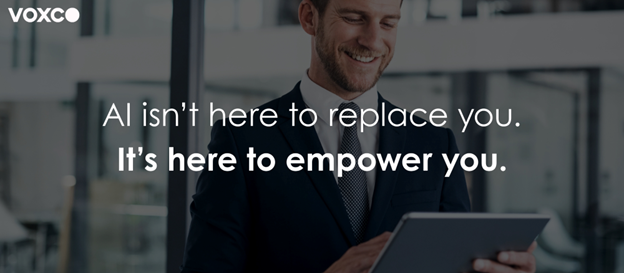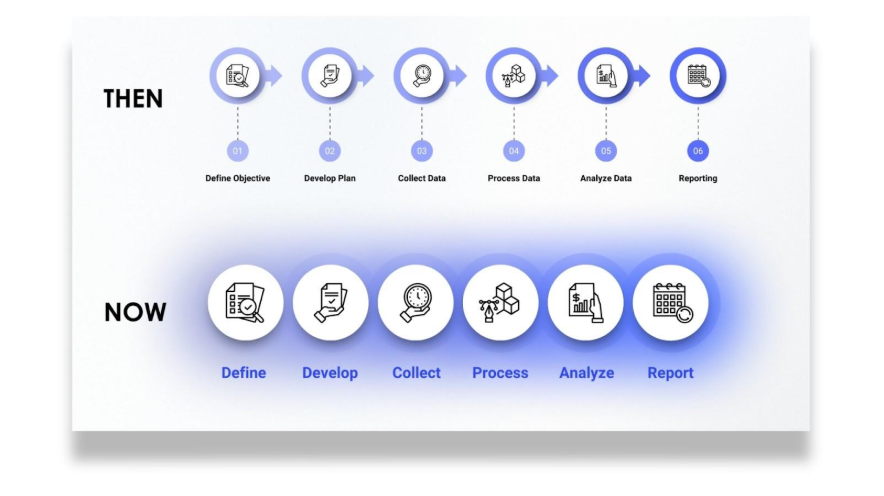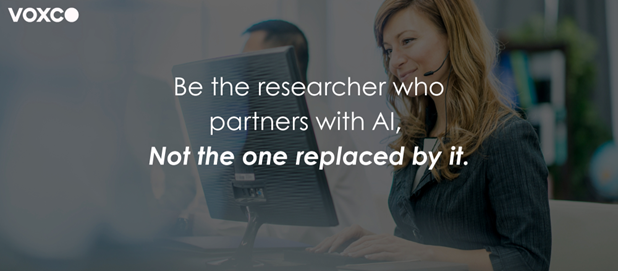Written by
Daniel Graff-Radford
CEO, Voxco
I’ve spent over two decades building technology companies. Before that I started my career in research and so building technology for researchers has brought me full circle. I’ve seen firsthand how big tech shifts can cause fear but also open new doors. AI’s impact on market research from 2023 to 2025 is profound: it’s changing workflows, roles, and outcomes. But here’s the truth—AI isn’t here to replace you. It’s here to empower you. Think of it as an experienced instructor standing next to you as you work and pointing the finger at what is important and better ways to do things.
I’m the CEO of Voxco, a leader in survey and text analytics technology, working at the frontline where AI meets market research. This isn’t speculation—it’s real change unfolding in companies I work with daily. I’m sharing what I’ve learned to help you thrive in this new landscape.
The Collapse of Traditional Roles Is Happening — and It’s a Good Thing
From survey designers and data analysts to insight strategists, AI tools are combining many tasks into one streamlined process. This shift means:
- Surveys that once took days to program are made efficiently with AI, reducing human hours.
- AI chatbots can now conduct interviews and focus groups, cutting down on the need for human moderators.
- Data analysis that required weeks is now done in minutes with natural language processing and automated significance testing.
- Once feared for their complexity and cost, open-ended questions now flourish—empowered by AI’s ability to summarize, categorize, and scale understanding.
- Automated reports with narrative insights and recommendations come out in seconds, not days.
One perspective is that this consolidation is a bad thing for workers, another is that this is a blurring of roles that brings more productivity to our field. Some people will come out of this with vastly more value to their customers and the market. Those are the people that learn to work through these blurred lines of roles. Shifting your focus from lower level to higher-value analysis and strategy could make you even more valuable to your organization or team.

The Current Market Shift and What That Means for You
We’re already seeing a fundamental shift in both the fabric of how we conduct research and the speed at which we analyze data. Take a look behind the curtain:
- Screen Engine uses AI to analyze moviegoer feedback in near real-time, enabling studios to tweak marketing and editing quickly before release—saving money and improving results.
- Ascribe AI automatically generates rich reports from open-ended survey data, combining qualitative and quantitative themes in seconds.
- A Wisconsin School of Business study found generative AI can deliver qualitative insights comparable to seasoned human analysts, speeding up deep thematic analysis.
But the shift isn’t just at the study level; both teams and organizations are seeing large scale change:
- AI reduces routine survey and data work by over 90% in some cases.
- According to University of Leeds research, AI could improve business efficiency and cut costs by 30% by 2035 in data-heavy roles.
- McKinsey reports firms using AI analytics have 20% higher productivity and innovate 30% faster.
If you’re feeling a seismic change reverberating beneath your feet, take heart. Although traditional junior roles like survey programmers and entry-level analysts are shrinking, there is an opportunity here to own the future if you are willing to evolve. Being of value and rising to the challenge won’t rest on manual data crunching. If you’ve already shifted focus to AI oversight, interpretation, and ethical insight generation, you’ve won 80% of this change already.
Here’s Your Market Research Career Roadmap in the AI Era
Given these changes, it’s smart to lay out a plan for how you might create extraordinary momentum in your marketability in a matter of years. If you can see the terrain changing, why not build a perfectly adapted vehicle to take you toward the horizon?
Step 1: Master AI Tools & Interpretation
This is your time to get acquainted with the landscape and familiarize yourself with the newly available tools. Getting your tools to a point of being ready for projects, means using them right away:
- Starting from scratch? That’s fine. Start using 2-3 LLMs (ChatGPT, Claude, etc) as a thought partner in your research.
- The more you teach the models about who you are, what you do and refine the rules of working with you, the more you will get out of them. It is like a friendship in a way; being authentic and open leads to better results.
- Now you are ready to use the tools in your projects for AI output quality and spotting errors.
- Try some of the coding open-ended response analysis and sentiment detection tools.
- The most important part of Step 1 is to just get started. Experiment. Failures lead to learning.

Step 2: Become an AI-Augmented Researcher, Blurring the Lines of Traditional Roles
After Step 1, you’re in the trenches and you know what’s available and how it performs. You’re becoming a master at coaxing insight out of AI. As you gain momentum, you might:
- Guide AI in custom insight generation.
- Develop expertise in integrating AI findings with business context.
- Hone storytelling skills to translate data into strategy.

Step 3: Lead AI-Driven Insight Strategy, Changing Your Whole Business
This is your time to mentor others and to start to lead out the discussion of where market research can and should go next with AI-augmented research. Asking questions about what limitations are removed by your new efficiency will lead to whole new strategies. Strategic moves might be to:
- Change how you work with customers on projects - how much more data can be provided for projects such as product launches, pricing analysis, sentiment analysis at the same budget they have had before? What better decisions will your customer make and what better outcomes will they have with this added analysis you can provide?
- How can you measure a ‘before’ state of traditional market research, and this changed model you have built? How can you use that to win new customers or expand work in the ones you already have?
- Can you build a new flexible model for how work gets done in your firm? Shape ethical guidelines and quality standards for AI research use.
- Mentor junior analysts to adopt AI fluency and this new model.
Step 4+: Innovate & Influence
This is what you’ve been building toward - ones where your thought leadership is valued because you’ve been in the trenches, know the tools and can see how AI-augmented research functions across platforms. You might:
- Pioneer new AI-driven research methods and platforms.
- Advise leadership on AI’s impact on market and customer understanding.
- Build cross-functional teams that leverage AI for continuous decision-making.
You’re In the Driver’s Seat if You Can Adapt
Yes, some roles are already diminishing to partial roles, but getting current with new tools and skills will accelerate you to the top of the list for newly created roles that will inevitably follow. Imagine a world where analysts become insight orchestrators, survey programmers become research program designers and all research professionals provide far more insights than ever before.
Goldman Sachs estimates 18% of jobs globally could be automated by AI—but many market research roles are evolving, not vanishing. It's time for reimagining and adaptation.
The Big Picture & Final Thoughts - Think with Abundance
AI is pushing down the cost of research dramatically and speeding up insight cycles by factors of 10 or more. This is deflationary—it means research becomes cheaper and more accessible, benefiting businesses and consumers alike. Stop imagining a world with the same amount of data for a lower price and start imagining a world with far more data within shorter time periods - this thinking with abundance will lead to better outcomes for your customers’ outcomes, your team’s success and the market’s growth. At the same time, faster, richer insights drive innovation and economic growth. Per Brad Gerstner, AI-driven productivity gains are expected to add $10 trillion of global productivity per year over the next several years, which is an almost unfathomable change to our world and is almost completely driven inside knowledge work - like Market Research.
The AI revolution in market research is real, but it’s not a threat if you are game to adapt—it’s the biggest opportunity of your career. Those who harness AI’s power will accelerate their careers, deliver better insights, and help their companies innovate faster. Be the researcher who partners with AI, not the one replaced by it - that is only the beginning, the real win is to be part of the elite team of researchers that drives our market to a place of abundance.
And remember, it’s not about owning the machine; it’s about knowing how it works. When word processers came along, just like AI today, they were there to stay and get only better with time. Word processors did not replace writers—they amplified them. In the same way, AI doesn’t replace thinking; it rewards those who think clearly and know how to ask the right questions.
If you want to dive deeper, I’m always open to sharing what I’ve seen at Voxco and across the industry. Together, we can turn AI from a fear factor into a career accelerator. Click here to connect with me on LinkedIn.





%20(1200%20x%20924%20px).png)


